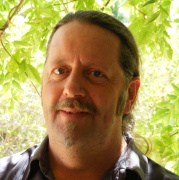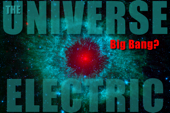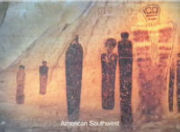Lucky It Ain't Rocket Science (LIARS)
01/06/2008
I make no apologies for having my tongue planted firmly in my cheek as I write.
Below, an example of where the peer-review process has taken us over
the past 50 years of gravity-only cosmology, to the exclusion of the
Electric Universe.
My comments in [square brackets].
From New Scientist 19 September 2007
primordial+black+holes+inflation+WMAP+cosmic+microwave
+background+CMB+Planck+satellite [=garbage]
Did the big bang spawn trillions of black holes? [No]
17:14 19 September 2007
NewScientist.com news service
David Shiga [as irreverently reviewed by David Smith]
Were vast numbers of black holes spawned during our universe's earliest moments? It is an intriguing idea, made possible by the extreme densities [of it's proponents] associated with the [unproven] big bang.
So far, there is no hard evidence [no evidence whatsoever], that such primordial black holes (PBHs) ever existed [that ANY black holes ever existed] but new observations just around the corner could change that [we're interpreting observations which have not been observed yet].
Detecting them would be a tremendous boon, [considering they don't exist...] because they could be used to probe [ouch!] the very early universe a mere fraction of a second after it all began, when the conditions were so extreme that our best physics theories have trouble describing them [that our 'best' physicists are using seriously flawed models]. Primordial black holes might also make up part of the mysterious invisible substance [theoretical non-substance] called dark matter that seems to make up most of the matter in the universe [because we refuse to acknowledge electricity's role in space...].
There are a variety of ways that PBHs might form in the inferno of the early universe [and a variety of ways they might not...]. For example, concentrations of energy associated with exotic energy fields could collapse under their own gravity according to Einstein's relativity, energy exerts gravity just as matter does [energy exerting gravity?] to make black holes. One such energy field is thought [by people who should know better] to be responsible for the rapid expansion of the early universe, a phenomenon called inflation. [Oh, another invokation to explain another unproved theory]
A wide variety of masses for PBHs are possible, [or impossible] depending on the formation scenario [depending on what measurements we can't explain without using the "e" word...].
The least massive ones, with less than about the mass of a comet, or 1 trillion kilograms, [so now comets all have a mass of around 1 trillion kilograms] would quickly evaporate [like dirty snowballs...] through a quantum process known as Hawking radiation.[explains why we haven't found any less massive ones to
date...]
Detonating black holes [Space Fartz]
There have been unconfirmed reports [There has been wild speculation] of radiation from slightly more massive PBHs, the last traces of which would just be evaporating now [how convenient] (see Black holes detonating all over our galaxy) [(see more garbage)]
More massive PBHs, which may be born with up to 100,000 times the mass of the Sun, [where's the intermediate PBH's, you know, the ones between 1 trillion kilograms and 100,000 Sun masses? Or did they, slowly evaporate?...] could survive [if they existed] to put an imprint on the cosmic microwave background
(CMB), radiation emitted by warm matter roughly 400,000 years after the big bang. [or radiation emitted by our own galaxy, if electricity does do something in space...]
That's because [very bold, suddenly it's established fact...] the black holes emit X-rays [must ask my dentist where he hides his black hole...] as they swallow matter from their surroundings, [er, why?] and these X-rays can escape the vicinity of the black holes to break apart, or ionise, hydrogen atoms. [why
couldn't electrically generated X-rays ionise hydrogen atoms? Oops forgot, the electricity in space doesn't do anything] This would subtly affect how matter distributes itself into regions of high and low density - a distribution reflected in the cosmic microwave background radiation. [if the CMB interpretations were correct]
This effect might explain a puzzling discrepancy between results of the Wilkinson Microwave Anisotropy Probe (WMAP), which measures the CMB [which measures microwaves], and studies of how galaxies are clustered. [We really can't explain the WMAP data...]
The two disagree on a parameter called sigma8, which describes how matter clumped together in the early universe [in the unproven early universe]. But according to a recent study led by Massimo Ricotti of the University of Maryland in College Park, US, the two measurements agree if PBHs are included in the
models. [so if we invent PBH's, we can explain away the anomolies]
But Ricotti himself says it is too soon to claim there is evidence for primordial black holes. [well deeerrrrrrr] It is still possible that refining the measurements [fudging the figures...] will bring them into agreement without invoking these exotic objects, he says. [will give us an option if people don't buy this garbage, he says]
First stars
The study also suggests that the ionising effect of PBHs would have helped spark the formation of the first stars in the universe. [after which stars chose
a different way to form] The presence of free electrons helps pairs of hydrogen atoms to join together to form molecular hydrogen. "You form a lot of molecular hydrogen about 10 to 100 times more than you would form if you didn't have primordial black holes," Ricotti told New Scientist. [you mean you can't really explain the amount of molecular hydrogen observed, so you invent PBH's]
Molecular hydrogen helps to cool gas clouds by emitting radiation, allowing the clouds to contract enough to condense into stars. Ricotti says the James Webb Space Telescope, scheduled to launch in 2013, just may be able to detect this enhancement of star formation. [if we interpret the data according to this
fantastical model...]
Perhaps most intriguingly, if primordial black holes survive in great enough numbers today, then clouds of them could account for some or even all of the mysterious dark matter that seems to make up most of the matter in the universe. [Oh, so dark matter may not exist??!! - Heretic!!! Burn the witch!!!]
The main problem with this possibility is that it is not clear whether the conditions needed to form PBHs in large numbers ever occurred in our universe. [The main problem with this possibility is there is already elec... oops the 'e' word again, I better shut up or kiss my PhD goodbye...]
In the formation scenario involving the inflation field, for example, the number of PBHs formed depends on unknowns [never stopped you before...] such as the size of fluctuations in the inflation field. "In some inflationary models, you can form a lot of PBHs; in others you form very few of them," Ricotti says. "It's not obvious if they form in sufficient numbers to be interesting." [it's not obvious inflationary models work at all]
Window to the past
It is possible that unusually large amounts of ionisation in the early universe - possibly due to the X-rays emitted by PBHs [which reminds me, I must get that filling replaced] - could be detected by Europe's Planck satellite, scheduled to launch in mid-2008, says WMAP team member Rachel Bean of Cornell
University in Ithaca, New York, US. "It's conceivable that such effects could be measured by Planck," ["lots of wild things are conceivable with a vivid imagination..."] she told New Scientist.
If convincing evidence of primordial black holes ever emerges, [there's no evidence yet] it would give scientists an extremely important window into the universe at very early times. "Proving that even very few primordial black holes exist would teach us so much about the early universe," Ricotti says. "We don't know much [anything] about those [hypothetical] times."
The mass of the black holes would reveal the time at which they formed, since the different scenarios for their formation occur at different times and give different masses [so we can keep fudging until we come up with something that 'works'...]. If they formed at the end of inflation, then their existence would reveal important information about the murky [thick] physics of this period of rapid expansion.[And as weve demonstrated many times, when the physics becomes more murky, the conclusions become crystal clear.]
"You could rule out models of inflation that don't produce these black holes," [or you could rule out any inflation models] says physicist James Chisholm of Southern Utah University. "Someone would probably get a Nobel prize." [perhaps a plasma physicist?...Oh hang on, one did BUT WE IGNORED HIM...]
[end]
Seems they'll allow anyone to write up science stories these days...
***No cosmologists were harmed during the writing of this parody***
Special thanks to New Scientist for supplying such nutritional fodder
Permalink to this article.
Public comment may be made on this article on the
Thunderbolts Forum/Thunderblogs (free membership required).
For a comprehensive central repository of links to study
Plasma Cosmology/Electric Universe please visit:
PlasmaResources.com
|

Dave Smith (davesmith_au) is an independent researcher and Managing
Editor of the Thunderblog.
My Archives
Chronological Archives
Archives by Author
Archives by Subject
Thunderblogs home
|




